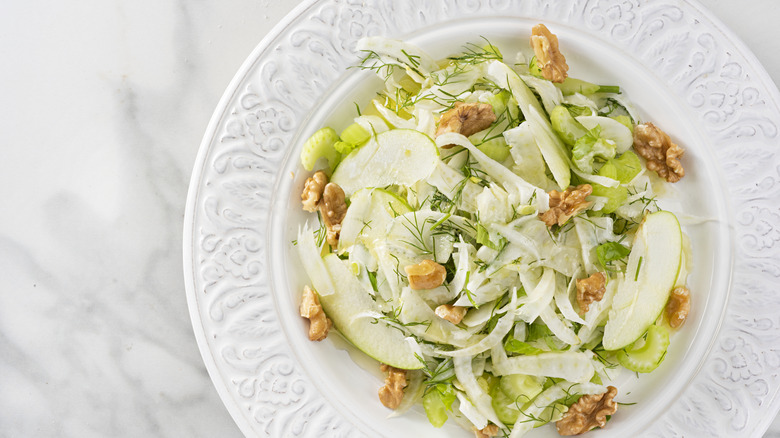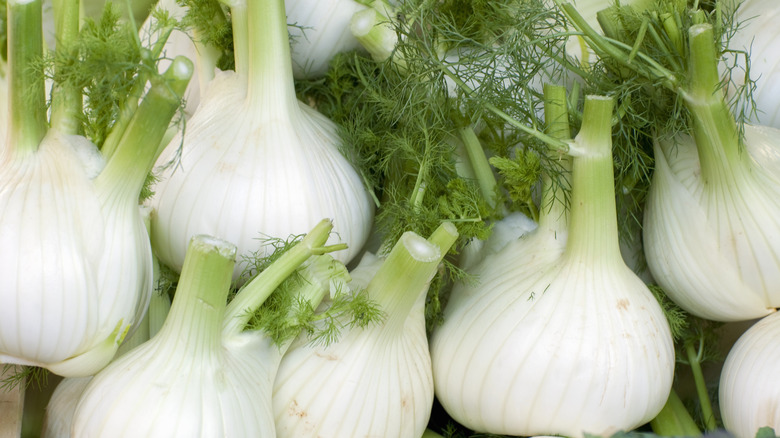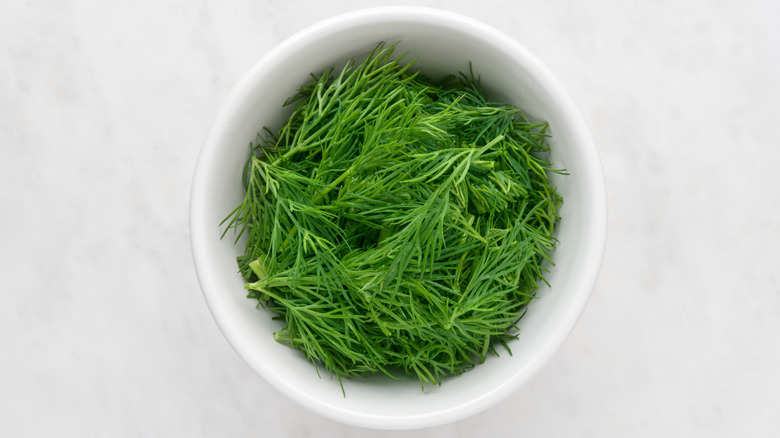Don't Confuse Fennel And Dill. There's A Difference
At first glance, fennel and dill might seem like culinary twins. With their similar feathery green fronds, it's easy to mistake one for the other. But when it comes to flavor, aroma, and how they're used in the kitchen, the similarities end. Fortunately, once you learn how to spot each of them, and learn how they taste and what they're used for, it becomes far easier to tell them apart.
Although the fronds of dill and fennel are quite similar, fennel grows from an edible bulb, while dill grows from a stem. Upon closer inspection, you'll notice subtle differences in the fronds, but it's the distinct scents and flavors that truly differentiate the two. Dill has a fresh, slightly tangy aroma with herbaceous and citrusy notes, and a mild, grassy taste. In contrast, fennel features a pronounced sweet scent reminiscent of licorice, with a bold, sweet flavor that carries distinct licorice-like notes, making it both refreshing and slightly spicy. These differences make them uniquely suited to different culinary applications, though they are sometimes used together, like in this salmon dill pasta salad.
Uses for fennel
If you're suspicious of fennel because of its licorice flavor, don't be. It actually works incredibly well alongside flavors like citrus and tomato, and is delicious fresh or cooked. The fennel bulb is the part that you use, but the fronds are edible, too — they're just mainly used as a garnish. The bulb is typically thinly sliced when eaten fresh and chopped when used in cooked dishes or roasted. Fennel is sometimes sold at grocery stores as anise, but those are actually two different things. Anise is typically used as a spice, as anise seeds have an intense flavor similar to licorice — they are frequently used in Italian sausage.
If you want to experiment with fennel, try it thinly shaved in a salad with oranges or grapefruit. You can also roast it, which mellows the flavor, and use it in salads or as a side dish. Make a pasta sauce with tomato and fennel, or blend up similar ingredients for a soup. Pair it with roasted chicken or your favorite fish.
Fennel's subtle sweetness and light licorice notes add depth without overpowering other ingredients, which is why it pairs so well with bright, acidic flavors. The unique combination of sweet and savory makes fennel an ideal complement to rich ingredients like olive oil, cheese, and even meats, balancing and brightening dishes with its fresh, yet complex flavor.
Uses for dill
Dill, on the other hand, is less of a star ingredient and more of a subtle flavor enhancer. While it's most famously used in pickles and potato dishes, dill's versatility extends far beyond those. Its bright, tangy flavor brings freshness to creamy sauces, salads, and fish dishes, adding a light herbal note without overpowering other ingredients.
Dill is a staple in many cuisines, notably in Scandinavian, Eastern European, and Mediterranean dishes. It's commonly used to flavor fish, soups, and yogurt-based sauces in these regions. You can find dill sold both fresh and dried, though fresh dill has a brighter, more vibrant flavor. Dried dill, while convenient, tends to have a milder taste and works best in cooked dishes where its flavor has time to develop.
The dill seed offers another way to enjoy a unique flavor. When toasted, they have a similar flavor to caraway, and may also be paired with caraway plus anise and celery seed, as well as appearing in pickling spices. It's common in meats, stews, and sauces, as well as certain dense breads.


